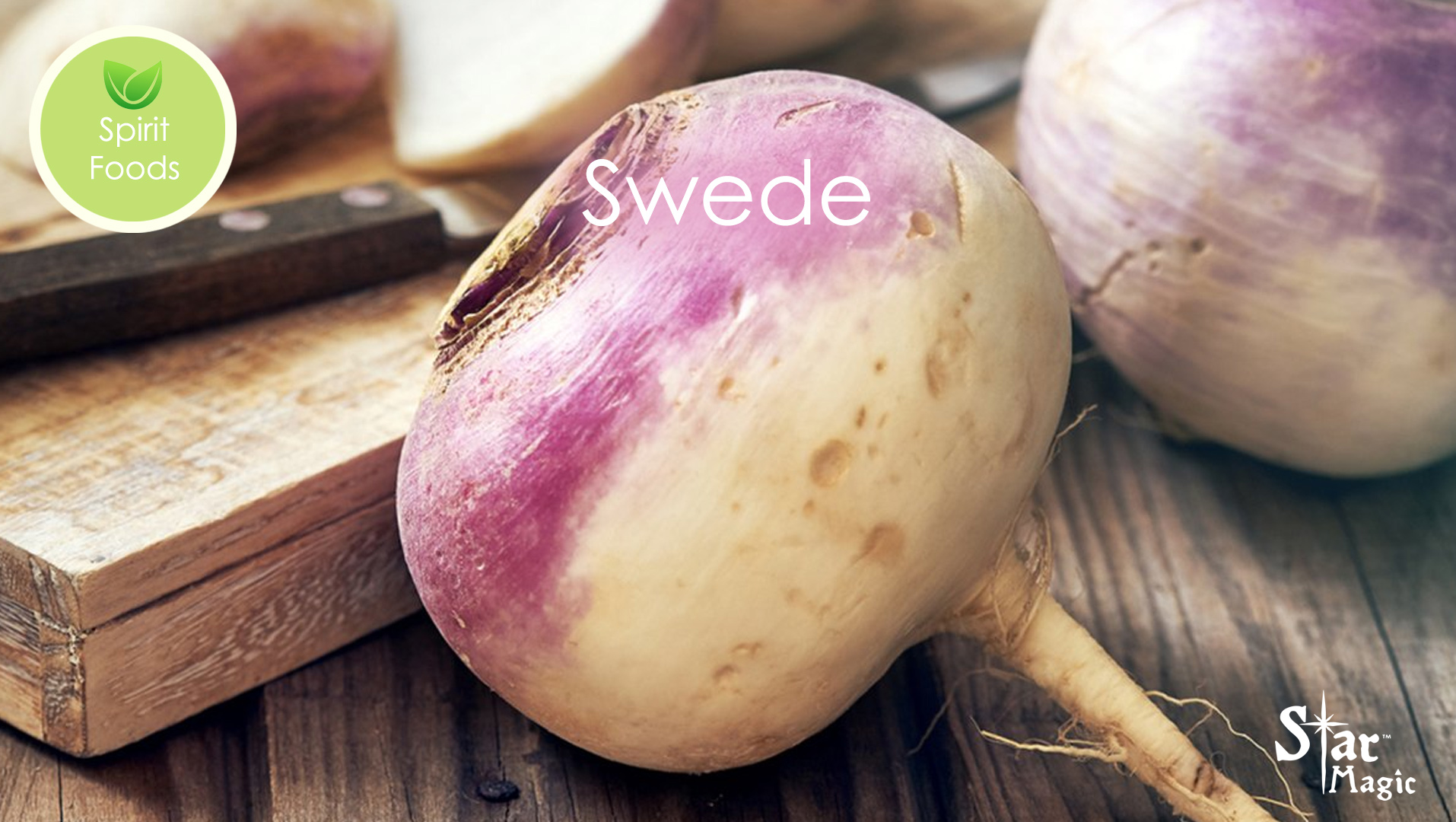Spirit Food – Swede (Rutabaga)

ORIGIN
The swede is a root vegetable that belongs to the cruciferous family. The other family members include broccoli, cauliflower, kale, and cabbage. The swede is one of the hardiest root vegetables to harvest and they grow seasonally from autumn through to winter.
The Swede is an agricultural cross or hybrid between the cabbage and the turnip. The roots are eaten in a variety of ways and the leaves can be eaten as a leaf vegetable. Swedes are known as ‘neeps’ in Scotland and as Swedish turnips and rutabaga elsewhere.
Swedes are rounded in shape with a purple-green skin fading in colour towards the base. The flesh is a creamy-yellow colour. Swedes are larger and more yellow and they stay tender at larger sizes than turnips which appear smaller and are white and purple.
The swede originated in Sweden and also in Bohemia in the 17th century. It is called a swede because it came from Sweden and rutabaga in America. The earliest reference to the vegetable was in 1620 when the vegetable was found growing wild in Sweden.
Swedes are also recorded as being used in Southern Europe where they were first eaten by humans as well as used for animal fodder. Different cultures have since developed their own ways to use Swedes for food, animal feeds, and as objects for spiritual protection.
In Britain and Ireland where pumpkins were unknown until a few hundred years ago, jack o’ lanterns were made from turnips and rutabagas. At Halloween, they would be hollowed out and carved with a face and then carried around with a candle inside.
Rutabaga was once considered a food of last resort in both Germany and France due to it being one of the few vegetables available during food shortages in both world wars.
CHAKRA – Root & Sacral
PHYSICAL BENEFITS
Swedes are very healthy to eat because they contain a wide range of vitamins and nutrients. They are a good source of fibre and carotene and also contain manganese, potassium, magnesium, calcium, iron, and zinc.
Swedes are also high in vitamins A, C, E, K, and B6. A 100g serving of swede has 41% of your recommended daily intake of Vitamin C. A boiled swede has only 11 calories per 100 grams so they are excellent for calorie reduction diets.
Swedes help with diabetes and weight loss. Eating swede helps you if you are insulin resistant or have diabetes. High fibre vegetables like swede are also beneficial for your metabolism. They are very filling while being low in calories.
Swedes help you improve your digestive health. The fibre in swede feeds your good gut bacteria and also helps you with constipation.
Swedes help to prevent and fight cancer. Each swede contains the antioxidant glucosinolate as well as carotene and vitamin C, which have been shown to reduce the growth of cancerous tumours by fighting free radicals and promoting healthy cells.
Eating swedes also helps you to fight free radicals. This also helps to prevent premature ageing, improves your eyesight, and helps with stimulating the regeneration of cells in your organs and tissues. Also, vitamin C is a necessary element in the production of collagen, for healing skin, tissue, muscles and blood vessels.
Swedes help to improve your immune system. The vitamin C in swede stimulates your immune system to produce white blood cells.
Eating swedes help you to build strong bones. Swede contains a wealth of important minerals, including zinc, calcium magnesium, manganese and phosphorous. They are all essential for maintaining healthy bones and tissues. Keeping your bones healthy will prevent osteoporosis.
Swedes are also good for your blood pressure and cardiovascular health. The potassium in swede can help lower blood pressure by reducing stress. The fibre content in swede also helps to reduce your cholesterol levels.
SPIRITUAL BENEFITS
Swedes are root vegetables and they give you an anchor to ground yourself in your spiritual activities and your daily life. They are great for your root and sacral chakras and facilitate a deeper earth connection when you engage in meditation after eating swede.
You can eat swedes and turnips to help you have good fortune in meetings and in meeting other people. They give you energy especially in winter and will keep you grounded in life’s challenges.
The ancient Celts considered turnips to have spiritual powers of protection. Turnip jack o’ lanterns were hungover entrances and carried around used to ward off spirits on Samhain (Halloween). Swedes are also used as lanterns before pumpkins were discovered.
CONNECT WITH SWEDE
You can eat Swede raw. It is crunchy and has a stronger taste with some zing like a radish. Raw swede can be grated and added to a salad like coleslaw. They can be prepared with a bowl of chopped Carrots in fresh cold water.
You can trim and peel swede. Swede has a sweet, earthy flavour when cooked. Cook swede until they are tender and soft. If overcooked they can fall apart.
Eating swede is a great substitute for white starchy potatoes. Have mashed swede instead of mashed potato or swede chips. Swede is also brilliant when cut up into wedges, roasted, and tossed through a salad or stirred into a veggie curry.
Swede is an excellent winter food. It is great in stews, casseroles, soups, roasts. Swede can be roasted, boiled, steamed, stir-fried, mashed, diced and added to soups and stews.
Add swede to mashed sweet potato or cauliflower to get more nutrients. Swede is also useful as a filler food in casseroles that adds lots of flavour as well as filling you up.
Platinum Package
"*" indicates required fields
Healing For Horses Enquiry Form
"*" indicates required fields
Sign up for our weekly newsletter, for inspiration and fresh content from Jerry Sargeant.
Event Enquiry Form
"*" indicates required fields
Sign up for our weekly newsletter, for inspiration and fresh content from Jerry Sargeant.
Download Prospectus Form
Download Prospectus Form


